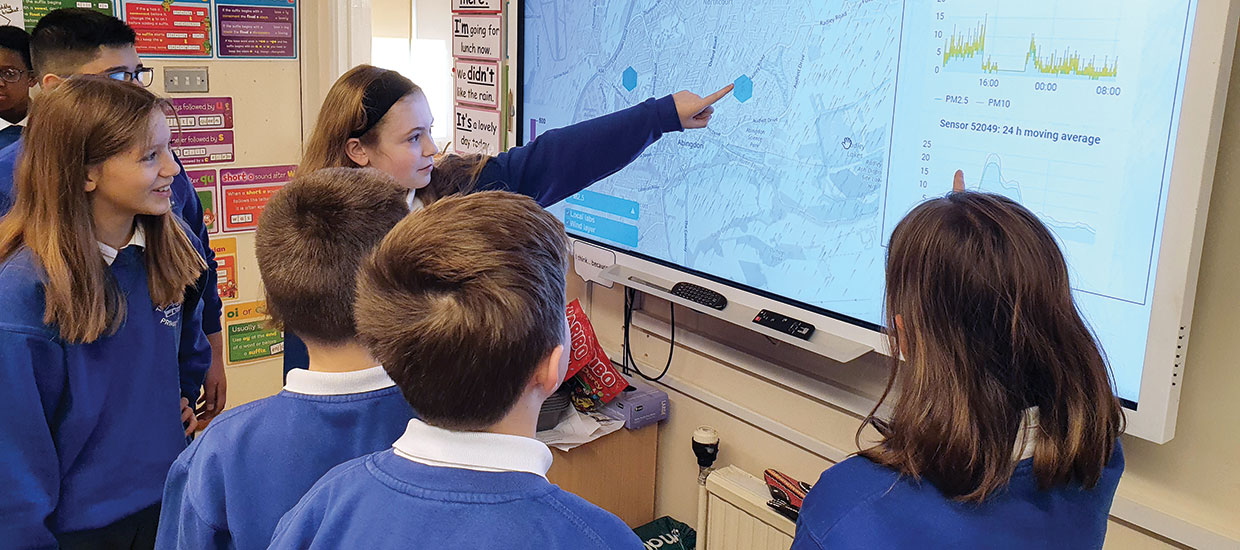A catalyst for partnerships
How a £5,000 grant from the Royal Society of Chemistry funded a multi-school project to monitor air pollution
Jeremy Thomas, coordinator of Abingdon Science Partnership, speaks to FundEd editor Jane Hughes

‘My role at the independent Abingdon School in Oxfordshire is to coordinate the Abingdon Science Partnership, facilitating STEM enhancement activities across our local state school network. Through this I have networked with science teachers in the Abingdon Partnership for Schools (set up and funded by 27 state schools when the LEA scaled back its activities due to cuts).
One of these teachers was Holly Irving, science and environmental coordinator at Caldecott Primary School. During last year’s lockdown, I chatted with Holly about the reduction in air pollution and, soon after our conversation, I saw a tweet from the Royal Society of Chemistry (RSC) offering grants of up to £5,000. It struck me that we could apply for funding for an air-quality monitoring project. Abingdon is at the centre of the “science triangle” between Oxford, Harwell and Culham, and, with poor public transport, the town often experiences huge gridlock and air pollution problems. So monitoring exactly what was going on over a year would provide valuable data for addressing this issue.
We decided that air quality was an important issue with which to engage pupils as it has tangible effects on their health and wellbeing, as has been highlighted recently in national news stories. Raising awareness of how individual actions can reduce local air pollution also links indirectly to a reduction in greenhouse gas emissions from the same sources. It also addresses calls for schools to better equip pupils to deal with the climate emergency.
I floated the idea across our partnership schools. Holly was enthusiastic, as were other teachers. We put together a proposal to fund several Raspberry Pis (credit card sized computers with plug-in options) into which we could plug air-quality sensors. Our proposal also included a year’s supply of diffusion tubes to monitor nitrogen dioxide levels at 12 school sites.
The application was quite in-depth and it specified that we needed a project sponsor who was a member of the RSC. So I put out an appeal via the PSCI-COM network of science communication specialists for a sponsor.
The response was overwhelming. Indeed, one of the scientists who contacted us turned out to be vice-chair of the RSC Environmental Chemistry Group. She put us in touch with other scientists and soon we were able to create a whole science team for the project, including a national expert who used to run an air pollution network for DEFRA, and an atmospheric chemist at the University of Chile!
It was a tremendous boost to see how many scientists were eager to support a school project. Their help and expertise meant we were successful in our bid and has also provided an incredible opportunity for our pupils to carry out investigative science in the community with real field chemists.
The project began in September, and, like all good science investigations, it’s been a process of adaptation to circumstances. We’ve discovered many ways we can develop the work further, while some ideas just didn’t work in practice. Our aim is for the children to take ownership of this project. We have pupils at eight primary school and five secondary schools collecting daily weather readings, along with automated Raspberry Pi measurements and monthly diffusion tube results. This allows us to monitor pollution across the area for a year. The Raspberry Pis have a plug-in sensor to measure particulate matter (the most damaging of these are from diesel fumes and wood burning).
Once a month, I take the diffusion tubes to a lab where the data can be analysed. Holly’s science club is recording and collecting data, while other schools do this as part of a class project. Sixth formers from Abingdon School, Larkmead School and Radley College are mentoring the primary school pupils remotely, while Year 7 and 8 science clubs at John Mason School and Fitzharrys School are also taking part.
One of our sixth formers discovered an online international air-quality monitoring network. By registering our sensors on this network, we are able to access data on air quality across the world. The sixth formers can programme and plug in the sensors, but not all our primary schools have the necessary IT support, so we’re looking at how we can make this work.
The project has become the focus for our Schools Science Fair at Abingdon’s ATOM Festival, where the pupils’ work will be exhibited in March. For British Science Week (also in March), each of the schools will make a video clip for a virtual conference about our project. The pupils are also making posters to display at the town museum.
By June, we will have a year’s worth of data. With this as our pilot, we hope to get funding for a bigger project to develop our work further. Another RSC member, Zoë Fleming from the University of Chile in Santiago, previously carried out projects with schools while working at Leicester University. She is keen to make our project part of an international network of schools that are monitoring air pollution.
In fact, she is currently looking for funding to begin this collaboration, which is very exciting for all of the pupils and teachers involved.’
RSC grants
Royal Society of Chemistry grants of up to £5,000 are available monthly during 2021, with application deadlines near the start of each month. Deadlines for large grants are 1 March and 6 September.
For more information, visit rsc.org
More on community partnerships
